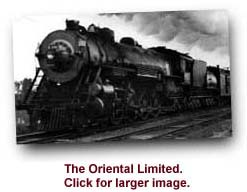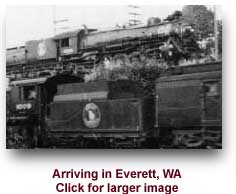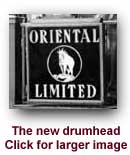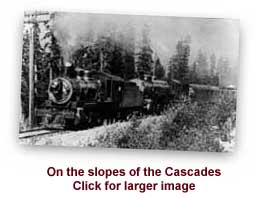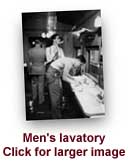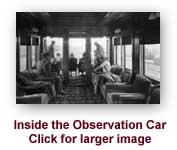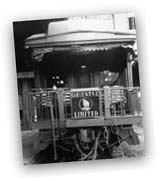Initially, the Mountains were limited to a maximum speed of 50 miles
per hour and made 4800 miles per month. The engines were single crewed,
a standard practice of the time. The 10 which were operated east of
Cut Bank were coal burners and the remaining 18 used west of Cut Bank
were oil fired. The P-2's were used eastbound on the Oriental through
New Rockford but not westbound through Grand Forks. The Mountains could
handle 10-12 cars up Walton Hill without a helper at 18 miles per hour.
[Reference sheet #122 provides additional information on the P-2
class Mountains.]
East of the Rockies, the H-4 Pacifics, which performed satisfactorily
in mainline passenger service continued to be used. The new H-5 proved
more successful than the H-4 and more were added to the remunda. Finally,
in 1925 a booster was added to the H-5 design and the H-7 was created.
The H-7 seems to have protected the Oriental between Spokane and Whitefish
from 1925. A picture of an H-7 on the point of the Oriental appears
in Wood's Lines West on page 70.
The Class E-14 Ten Wheelers had proven to be speedy and satisfactory
locomotives for certain types of passenger service. In 1924, they were
assigned Westbound between Devil's Lake and Minot, North Dakota, where
the maximum grade was only 0.6%. But, in spite of the wide firebox,
they lacked the boiler power needed for the work on the Oriental and
were soon withdrawn.
In anticipation of the new train, Great Northern rebuilt the class K-1
Atlantics which were fitted with superheaters and bolsters. The tractive
effort was raised from 23,000# to 33,000#. These locomotives were placed
in service between Wolf Point and Havre. It is interesting to note on
the chart that the K-1's, with the lightest tractive effort, were carded
for the fastest time over the eastbound run. Nevertheless, these locomotives
were gradually phased out as more H-5's and booster equipped H-7's were
built in 1925-26.
The Cascades were the domain of the P-2 Mountains. Initially, the B-B
Electrics were coupled on to the Mountains at Tye and Scenic for the
trip through the original Cascade Tunnel. This changed in 1927 when
the Z and Y class Electrics arrived and assumed the chore of towing
the P-2's through the tunnel. Starting in 1929, when the new Cascade
Tunnel was placed in service, the Mountains were cut on and off at Wenatchee
and Skykomish. A pair of Z-1 Electrics leading the Oriental over
the Foss Creek trestle are pictured in Wood's Lines West on page 137.
Building the New Cascade Tunnel meant that a faster schedule would be
possible. In anticipation of a new faster transcontinental schedule,
Great Northern decided to obtain locomotives of greater capacity. Six
Northern types were ordered from Baldwin. The S-1 class Northerns were
completed in May 1929 and immediately assigned to the Oriental. The
S-1 was better fitted for work on long grades where sustained high power
was required. Until 1931, when the Oriental was withdrawn, these locomotives
were used exclusively in passenger service between Havre and Whitefish.
They handled as many as 18 heavyweight cars in both directions. If there
were more than 13 cars a helper was added over Walton Hill.
In
March and April 1930, 14 S-2 Northerns were acquired. These fine locomotives
were intended for the Oriental Limited, Empire Builder and the Fast
Mail. Initially they were assigned to the Spokane - Wenatchee and the
Williston - Havre sections of the line. Both divisions featured the
long tangents, easy curves, and light grades for which the S-2's 80"
drivers were designed. Reference sheet #40 contains additional information
on the S-2 class.
THE
EQUIPMENT CONSIST
Eight sets of equipment consisting of the RPO/baggage, a first and second
class coach, a tourist sleeper, a diner, four sleepers, and an observation
arrived in 1924. Between 1924 and 1929 one more observation, upgraded
coaches, additional sleepers and diners were added to the equipment
pool.
In addition, express reefers were carried in season on the eastbound
train. These cars, destined for eastern markets, were laden with Northwest
fruit and produce. In Summer, car loads of both Puget Sound and Alaskan
Salmon, fresh off the Seattle docks, were expedited east on its faster
schedule . A picture of several express reefers on the headend of the
Oriental appears in Wood's Lines West on page 81. Coincidental to the
inauguration of the new Oriental, fifty additional express refrigerator
cars were built by Seimens-Stemble in 1924. Additional information
on these cars can be found in Reference sheet #165.
The interior of the entire train, from the coaches to the observation,
was decorated in the same uniform, harmonious, light green enamel scheme.
None of the cars were furnished with air- conditioning and this was
the last new train equipped with friction journals, as all subsequent
new passenger cars rode on roller bearings. The normal arrangement of
the ten car consist was the RPO/Baggage, second class coach, first class
coach, tourist, 12-1 Pullman, 12-1 Pullman, diner, 12-1 Pullman, 10-1-2
Pullman, Observation. In 1924, each sleeping car was assigned an alpha
designation as its line number. As a convenience to passengers, the
car designations were provided in the booklet Oriental Limited Train
Directory.
HEADEND
In the Spring of 1924, eight steel 70' RPO/Baggage cars from the 52-71
series were repainted and put in shape at the St. Paul shops. The cars
had been built in 1918 by American Car and Foundry, (AF&C) and were
the most modern headend equipment on the roster. At one end, the cars
were equipped with a 30' Railway Post Office apartment. In the middle,
separating the two areas, was a 10' fish rack area. Fish racks were
duck boards in the floor which permitted melting ice to drain without
spoiling the perishable shipments. At the other end, the baggage and
express area contained a dynamo generator, safe, desk letter case and
toilet facilities for a baggage messenger. The dynamo provided thirty
two volt direct current power for the appliances, like the train's vacuum
cleaners, hair curling irons, electric toasters and valet's pressing
iron. Wood's Lines West on page 84 has a photograph of this car involved
in a wreck on March 11, 1928 at Peshastin, WA. Reference sheet #100
provides additional information on these cars.
SECOND
CLASS COACH
The smoking car involved a departure from the standard previously used
on deluxe trains. It provided space in the forward end for the dining
car crew's sleeping accommodations. Four tourist sections were built
in the forward end with sufficient locker and toilet facilities for
the crew. The space was later expanded to six sections. This arrangement
gave additional coach space in the daytime and accommodations for the
dining car crew at night. Experience had shown that there were always
more passengers using the coaches in the day time than at night. The
70' second class coaches were initially built by AC&C in 1913 as
standard coaches and carried the numbers 3700-3707. Steel sheathing
and underframe was applied to these cars in 1924 and they were renumbered
643-650 in 1926. As more diners were acquired, more of the 70' coaches
in the 3700 series were converted to this configuration. Between 1925-28,
all remaining cars in the 3700 series received steel sheathing.
FIRST
CLASS COACH
Initially, first class coaches numbers 950-959 were assigned primarily
for long distance passengers. These eighty foot all steel cars were
built in 1914 by Barney and Smith and had an eighty-six passenger configuration.
A change from the standard arrangement was the provision of a woman's
lavatory across the aisle from the woman's toilet. If traffic warranted,
coaches 960-979 which were almost identical, may have also been assigned.
In 1926, coaches 920-927 replaced the 950-959 series coaches. They had
been built by Barney & Smith in 1910 as 86 passenger standard coaches.
In 1925 and 1926 they were upgraded for use on the Oriental. Steel sheathing
was applied to the exterior and they received an enlarged mens room
as a smoker, which resulted in the seating capacity being reduced to
70 passengers. The interiors were painted the Oriental Limited shade
of green.
PULLMAN
BUILT CARS
The cars which Pullman built were all steel and represented latest designs
and the newest features available. The diners and sleepers contained
slightly different features, perhaps owing to the fact that the diners
were built for GN, and Pullman would retain ownership of the sleepers.
The May 24, 1924 edition of Railway Age provides the following information:
[Diners] "The mechanical specialties used on this car are as follows:
Commonwealth cast-steel six-wheel trucks, high equalized type with pedestals
cast integral with the frame and a device for locking the trucks to
the body of the car; 5-1/2 by 10-in journals; 36-in rolled steel wheels;
simplex clasp brakes; miner draft gear, type A-5-P-X; Miner buffer device,
type B-10; new York Air brakes, UC-1612 equipment; Woods roller side
bearings; Vapor heat and monel metal, used through out the kitchen and
pantry."
[Standard Sleepers] "The mechanical specialties on these cars are
as follows: Commonwealth cast steel six-wheel trucks, high equalizer
type with pedestal frames cast integral and safety locking pins; clasp
brakes, and 36 1/2-in rolled steel wheels on axles with 5-in by 9-in
journals." Additional information on the heavyweight diners
and sleepers can be found in Reference Sheet #110.
TOURIST
In
May 1924, eight cars were rebuilt by Pullman from older 12-1 sleepers
by converting the former men's room to the valet-barber shop and shower
bath. The drawing room was rebuilt for use as a men's smoking area.
Although tourist sleepers had been carried on the Oriental since 1905,
the eight tourist sleepers were an innovation because of the valet-barber
shop. The Tourist cars were divided into two sections and separated
by a door in the aisleway.
The forward part consisted of 12 tourist sleeper sections, which had
no bulkhead between berths. The women's retiring room and men's smoking
room were on either side of the berths in the forward section. The men's
and women's rooms were much larger and better appointed than had previously
been provided in tourist cars.
At the rear section, the car featured valet service, a barber chair
and men's shower bath. This change in the Oriental's design followed
a trend found on other important flyers of the Twenties. The mark of
big city Limiteds was to place a barbershop, frequently with a smoker/library,
in the forward end of the train. The best barbers were recruited from
metropolitan areas for this duty. The barber shaved passengers for two
bits and cut hair for four bits. Also in his joint capacity as valet,
he pressed a three piece suit for six bits and left the sleeves round
if you so wished. The barber/valet shop was equipped with a thirty-two
volt direct current activated electric pressing iron which was specially
manufactured for railroad usage. The train's vacuum cleaners and electric
toasters were also thirty two volt appliances. It is believed that the
tourist sleepers were numbered 1725-1732 but this has not been confirmed,
except for photos which exist of car 1728. The photograph indicates
that the car rode on standard Pullman six-wheel trucks, not the commonwealth
trucks used on the other Pullman built cars.
DINING
CAR
G.N introduced its 'State' series of dining cars on the new train. The
eight new dining cars were completed by Pullman in May 1924. They were
the first of an eventual 22 identical cars which would continue to operate
in mainline service into the Fifties. Each car accommodated 36 patrons
at each sitting, and carried a crew of twelve. The interiors were painted
in different harmonious shades of green. The adornment of the car consisted
of light tones throughout, giving the restful effect of a well decorated
room. Fresh cut flowers from G.N. greenhouses and gardens brightened
each table, and presented a pleasant impression on the bright white
linens and beside the shining crystal and silverware.
The dinner hour was announced by the traditional melodious chimes. The
menu featured Great Northern style chicken pie, baked salmon, Wenatchee
apple pie, G.N. beans and smoked ham. The nature of the area served
logically influenced the introduction into the dining car menu of such
items as Washington apples, clams, salmon and other territorial specialties.
The specialties included berries and vegetables from the Northwest,
prize winning Minnesota butter, and North Dakota beef. For breakfast,
Great Northern Health Griddle Cakes were offered.
Like all railroad diners, the menu advised patrons that employees were
forbidden to accept written orders. The Oriental's menu also invited
mothers to send baby's bottle to the dining car to be sterilized and
filled. In summer months, the eastbound Oriental slowed each day at
Stryker, Montana, so that the telegraph operator could hand up a package
of freshly caught mountain trout to dining car personnel, who quickly
prepared them for appreciative patrons. Diner patrons received a complimentary
copy of the recipe book Great Northern Secrets.
 |
The
car was built with an especially large and well-arranged kitchen,
which even had electric toasters. Monel metal was used through
out the kitchen and pantry. From this area, GN crews established
the well earned reputation for meal service. Unlike the sleepers,
Great Northern continued to own and operate the dining cars which
were serviced and supplied from G.N.'s commissaries. They were
located at Seattle, Spokane, Great Falls, and St. Paul. |
Initially, the diners carried both names and numbers. 7000-7007 were
ordered in 1924 and two more, North Dakota and South Dakota were received in 1925. It is believed that
these were the only diners lettered for the Oriental Limited. In 1926,
the cars were renumbered. However, the diners remained lettered for
the Oriental Limited until 1931.
| Name |
Orginal # |
1926 # |
| OREGON |
7000 |
1030 |
| WISCONSIN |
7001 |
1031 |
| MINNESOTA |
7002 |
1032 |
| IOWA |
7003 |
1033 |
| MONTANA |
7004 |
1034 |
| IDAHO |
7005 |
1035 |
| WASHINGTON |
7006 |
1036 |
| ILLINOIS* |
7007 |
1037 |
| NORTH
DAKOTA |
7008 |
1038 |
| SOUTH
DAKOTA |
7009 |
1039 |

